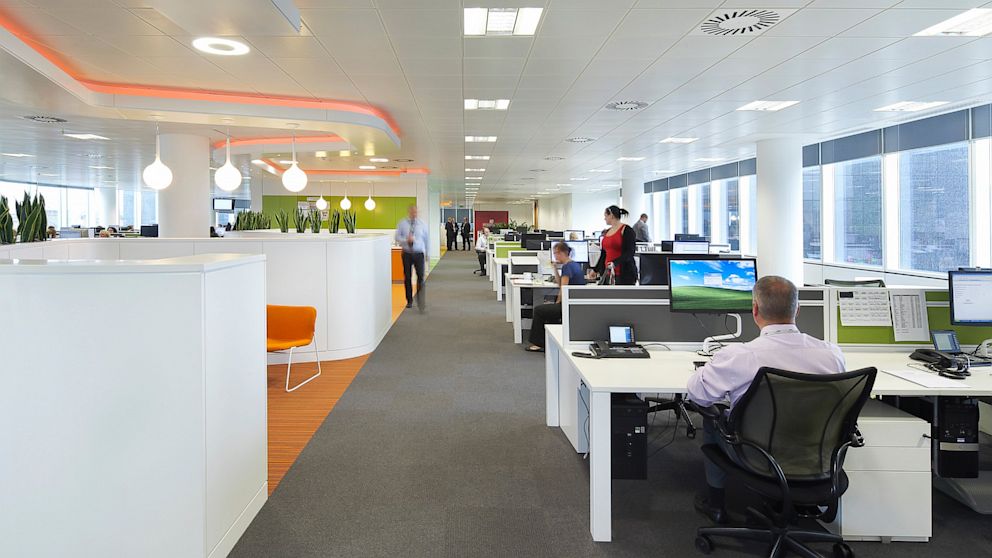Proof That Open-Plan Offices Are Satan's Handiwork
Oceans of office space with rows of desks, it turns out, is distracting.

July 2, 2013 -- Are you a wage slave toiling in an "open-plan" office—meaning, in a single giant room, without so much as a sheet of waxed paper separating you from the knowledge-worker seated next to you? If so, there's news both bad and good.
The good: Your private surmise--that this is the stupidest, most distracting least-civilized arrangement of humanity ever devised--turns out to be more or less true, on the strength of recent evidence.
The bad: According to the International Management Facility Association, 70 percent of U.S. office workers must contend with these distraction-rich environments, where the reason you can't hear yourself think is that you can hear the person next to you thinking.
Anyone not familiar with open-plan offices can consult the slave galley sequence of the movie "Spartacus."
Workers equipped with keyboards, monitors and phones (rather than with oars) sit cheek-by-jowl at giant trestle tables. They are not actually shackled; but all that's lacking is a bare-chested fat guy with an eye-patch, rhythmically beating a drum and yelling, "Stroke!"
Last week global design and architecture firm Gensler released the results of a survey of some 2,035 workers in different kinds of offices, across 10 industry segments. Those in open-plan offices reported difficulty focusing, hence difficulty working effectively.
Respondents, says Gensler, represented a broad cross-section of demographics, including education, age, gender and location. They included knowledge workers who work in an office some or all of the time. Statistical analytics were conducted by Precision Consulting.
Diane Hoskins, one of Gensler's co-chief executive officers, writes in an essay accompanying the findings that the trend toward open offices has been building since the 1970s, driven by the need for greater collaboration and better communication.
Facebook, for example, recently announced it will build a Frank Gehry-designed addition to its Silicon Valley campus that, when finished, will be the biggest open-plan office in the world.
WHAT FRANK GEHRY IS DESIGNING FOR WASHINGTON, D.C.
"In some cases," Hoskins now opines, "the pendulum may have swung too far, with too much emphasis on open communication and not enough on focus."
Under the header "What's Wrong With Most Workplaces Today?" she notes that workplace environments, "when not designed effectively, can have unintended consequences—the result is that many U.S. knowledge workers are less able to focus than in 2008, the date of our last survey."
Professor Tonya Smith-Jackson, chair of the industrial and systems engineering department at North Carolina A&T State University, has studied the various ways open-plan offices both facilitate and interfere with work performance. In a 2009 paper, she and co-author Katherine Klein, concluded that "irrelevant speech" (what the co-worker sitting next to you, for example, may be saying) "contributes to mental workload, poor performance, stress and fatigue." Open-plan offices, the co-authors write, "have been identified as problematic."
HOW MICROSOFT LAST REVAMPED ITS OFFICES
Smith-Jackson tells ABC News, "We saw performance decrements and reduced productivity overall." The reason, says she, was twofold: distractions (both verbal and visual) reduced workers' focus, and, at the same time, increased their mental workload. "It took more effort for them to get something done. It was more difficult for them to focus their attention."
The lower cost of an open-plan office may make it a tempting option, compared to a more tranditional layout, Professor Smith-Jackson allows. But that holds true only if the open-plan offers equal or better productivity. "The problem is," she tells ABC, "we found you don't necessarily get those productivity benefits. Depending on the dispositions of the workers, you can wind up with a terrible cost-benefit ratio."
She and Gensler agree the solution is to design better-balanced workplaces that address not just the need for collaboration but for private, focused thought (small room with a door).